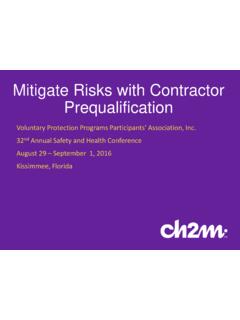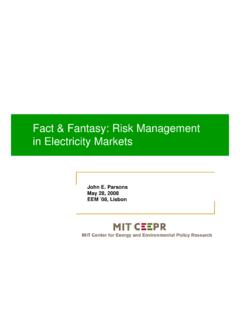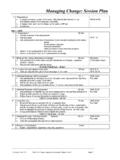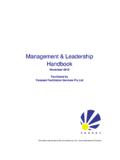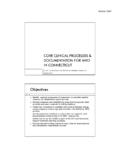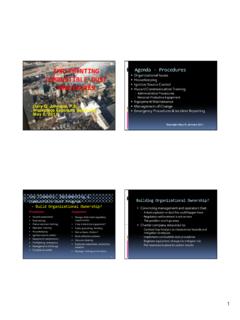Transcription of Another Means of Worksite Analysis NFPA 652’s Standard …
1 Another Means of Worksite Analysis NFPA 652 s Standard on dust Hazard Analysis (DHA) Another Means of Worksite Analysis NFPA 652 s Standard on dust Hazard Analysis (DHA)Presented by:Scott E. Genta, Director, Southwest OperationsMe Scott E. Genta is a chemical engineer with 22 years of experience in the practical application of technical safety disciplines in the hazardous chemical and explosives industries. Experience includes OSHA s Process Safety Management (PSM) regulation, and EPA s Risk Management Program (RMP). Currently an Ambassador with OSHA s Voluntary Protection Program (VPP) for the Region 9 Participants Genta has provided Process Safety Management and Process Hazard Analysis Training for many different companies and annually at the TCI Consulting course for DOD contractorsProject Highlights Include PHA for High Pressure Water Washout of 155mm Munitions in the Ukraine and Belarus PHA for the Alaskan Pipeline Site Safety Support for Munitions Manufacturing Facility Start-up in Mulwala, AustraliaSMS Capabilities Risk Management and Process hazards Analysis Methodologies Qualitative (HAZOP, FMEA, etc.)
2 Quantitative (Fault Tree, Probabilistic Analyses, etc.) Compliance OSHA PSM, EPA RMP, DOD, VPP Material Characterization Testing Sensitivity & Reactivity Testing DOT Classification Testing and Analysis Test Equipment Facility Siting & Design Quantity Distances, Venting, Barricades, Workstation Protection, etc. Training Risk Management Explosives Safety ISO/IEC Accredited Laboratory US Department of Transportation (DOT) Competent Authority DOT approved and authorized Examining Agency to perform explosives and other hazardous materials examination services Chairperson of the ASTM Subcommittee on dust NFPA Committee membership and contribution (NFPA 654, 655, 91, 664, 61 and 484). Delegate to the United Nations (SAAMI Delegation) Transport of Dangerous Goods Subcommittee-Explosives Global Harmonization Subcommittee-Explosives Chapter UN Explosives Working Group Delegate Participant with IGUS -International Group of Experts on the Explosion Risks of Unstable Substances Founder & Chair of the Explosives Testing Users Group Test sites in Burr Ridge, Illinois, Tooele, Utah, and Geleen, the NetherlandsIntroduction FAI & SMS TeamsRisk Management HeritageExplosives ManufacturingRisk Management HeritageFMEARisk MethodsImprovedFault TreesProbitAnalysisHerculesDupontOthersM aterialCharacterizationTestingOSHA29 &ModelingEPARMP19121960197019801990 PresentDustIncidents and OSHA EmphasisIncidentsDust explosions are a serious hazard, recent incidents include.
3 January 2003 -West Pharmaceuticals Services Kinston, North Carolina Fine plastic dust -6 fatalities many injured February 2003 CTA Acoustics Corbin, Kentucky fiberglass binder dust 1 fatality several injured October 2003 Heyes Lemmerz Huntington, Indiana Aluminum dust 1 fatality several injured February 2008 Imperial Sugar Port Wentworth, Georgia Sugar dust 14 Fatalities 38 InjuredExplosion ExampleWest Pharmaceutical -Operation kept clean -it was the fine plastic dust collecting above the false ceiling that propagated the reactionOverview of NFPA 652 Standard on the Fundamentals ofCombustible dust Why? Why was NFPA 652 Created-There are multiple commodity specific NFPA standards -Requirements are sometimes inconsistent between industry sectors and dust types-Defines the relationship between this Standard and others to address gaps or conflicts with requirements-Aims to simplify OSHA compliance and enforcementDust Occupancy standards NFPA 652 Fundamentals Wood/Cellulosic dust NFPA 664 Metallic dust NFPA 484 Agricultural dust NFPA 61 Sulfur NFPA 655 Pulverized Fuels NFPA 85 Coal NFPA 120 Chemical dust NFPA 654 When?
4 When does this take effect?-Unless otherwise specified, the provisions of this Standard shall not apply to facilities, equipment, structures, or installations that existed or were approved for construction or installation prior to the effective date of the Standard -What is retroactive? dust Hazard Analysis Chapter 7 Housekeeping Section Ignition Source Control Section Management Chapter 9 NFPA 652 Chapter 8: Hazard Management Mitigation & Prevention Housekeeping-A facility must have documented housekeeping procedures that include: Cleaning methods Frequency and goal TrainingNFPA 652 Chapter 8: Hazard Management Mitigation & Prevention Ignition Source Control-Hot work-Hot surfaces-Bearings-Electrical Equipment and Wiring-Electrostatic Discharges (portions are retroactive requirements)-Open Flames-Industrial Trucks-Electrostatic Discharges (portions are retroactive requirements)-Open Flames-Industrial TrucksNFPA 652 Chapter 9.
5 Management Systems Covers the administrative requirements needed to manage combustible dust hazards -Equipment Operation Procedures-Employee/Contractor Training Requirements (Hazard Awareness)-Management of Change (MOC)-Incident Investigation-Document Retention All requirements in this chapter apply retroactively NFPA 652 DHA Requirements NFPA 652 DHA Requirements NFPA 652 Chapter 7: dust Hazard Analysis (DHA) Owner/Operator must complete a DHA if facility is handling a combustible dust . This is a retroactive requirement-Existing process/facilities must schedule and complete DHA within 3 years of the effective date of NFPA 652 (9/7/2015)NFPA 652 DHA Requirements (continued) NFPA 654 June 2nd, 2021 NFPA 664 September 7th, 2018 (same as NFPA 652) NFPA 61 June 2nd, 2021 NFPA 484 Falls under NFPA 652 (waiting on new edition)OSHA s Voluntary Protection Programs Management GuidelinesWork Site AnalysisBaseline Hazard AnalysisNFPA 652 DHA Requirements Defined as a systematicreview to identifyand evaluatethe potential fire, flash fire, or explosion hazards associated with the presence of one or more combustible particulate solids in a process or facility The purpose is to identify hazards in the process and documenthow those hazards are being managedNFPA 652 DHA Requirements DHA shall evaluate the fire, deflagration, and explosion hazards and provide recommendations to manage the hazards in accordance with NPFA 652, Chapter 4 DHA shall be performed or led by a qualified person Results of the DHA review shall be documented, including any necessary action items, a change to the process.
6 Or materialsRisk Management & DHA Philosophy Safety by Design Minimize Personnel Exposure Minimize Quantities of Hazardous Materials Safety Specifications standards Procedures TrainingLevel SettingFundamental to Risk Management & DHAsLevel SettingLevel SettingPrioritizationOperation / Equipment Prioritization Identification of dust or potential for dust Testing per NFPA 652 Chapter 5 (screening)Level SettingPrioritizationNFPA 652, The absence of previous incidents shall not be used as the basis for deeming a particulate not to be combustible or explosive Level SettingPrioritizationPropertyDefinitionA STM Test MethodApplicationKStDust deflagration indexASTM E 1226 Measures the relative explosion severity compared to otherdustsPmaxMaximum explosion overpressure generatedin the test chamberASTM E 1226 Used to designenclosures and predict the severity of the consequence(dP/dt)maxMaximum rate of pressure riseASTM E 1226 Predicts the violenceof an explosion.
7 Used to calculate KstMIEM inimumIgnition EnergyASTM E 2019 Predicts the ease and likelihood of ignition of a disperseddust cloudMECM inimum Explosible ConcentrationASTM E1515 Measures the minimum amount of dust dispersed in air, required to spread an explosionAnalogousto the lower flammability limit (LFL) for gas/air mixturesLOCL imitingOxygen ConcentrationASTM E2931 Determinesthe least amount of oxygen required for explosion propagation through the dust cloudECTE lectrostatic Charging TendencyNo ASTM standardPredicts the likelihood of thematerial to develop and discharge sufficient static electricity to ignite a dispersed dust cloudMaterial Characterization Testing:Sensitivity and Reactivity Sensitivity MIE, MEC, MIT, Resistivity Reactivity Explosive Severity Kst, dp/dt, PmaxNot all dusts are the sameLevel SettingPrioritizationNPA 652 -Each processsystem where combustible dust is present or where particulate solids could cause combustible dust to be present shall be evaluatedLevel SettingPrioritization May use a simple table.
8 Operation/ItemExplosible dust Present (Fuel)Possible MEC (Dispersion)OxygenPossible MIE (Ignition)ConfinementFurther AssessmentBulk StorageIn PackagingNoYesNoNoNoMixing RoomYesUpsetYesYesYesYesDrum Loading of TankYesUpsetYesYesYesYesFillingTankYesUp setYesYesYesYesDust Collection SystemYesYesYesYesYesYesLevel SettingHazard IdentificationOperation / Equipment PrioritizationHazard IdentificationLevel SettingHazard Identification NFPA 652 Appendix B OSHA complexityof the hazards Analysis must reflectthe complexityof the processLevel SettingHazard Identification Methodology (continued)-Acceptable methods may include, but are not limited to: What-if Analysis Checklist & What-if Analysis Failure Modes and Effects Analysis (FMEA) Fault Tree Analysis HAZOP NFPA 652 Appendix B OSHA SettingHazard IdentificationNOTE From 652 Appendix B:It is not the intent of this Standard to require users to apply the PHA provisions of OSHA regulations in 29 CFR , Process Safety Management of Highly Hazardous Chemicals, in developing a DHA.
9 The example is intentionally vague to allow users to match the complexity and extent of the Analysis to the complexity and extent of the facility and its processKey Items For dust Thermal, ESD, friction, impact, shock, etc. Housekeeping, Spill, Process Leak, etc. Level SettingHazard IdentificationExample: hazards ChecklistTypes of EnergyLevel SettingHazard IdentificationLevel Setting Hazard Identification The DHA would not be complete without a review of NFPA 652 and the commodity specific standards Wood/Cellulosic dust NFPA 664 Metallic dust NFPA 484 Agricultural dust NFPA 61 Sulfur NFPA 655 Pulverized Fuels NFPA 85 Coal NFPA 120 Chemical dust NFPA 654 Level Setting Hazard Identification Don t Forget the Design standards : NFPA 68: Standard On Explosion Protection By Deflagration Venting NFPA 69: Standard on Explosion Prevention Systems NFPA 77: Recommended Practice on Static Electricity NFPA 13: Standard for the Installation of Sprinkler Systems NFPA 15.
10 Standard for Water Spray Fixed Systems for Fire ProtectionLevel Setting Hazard Identification Level Setting Hazard Identification Either a separate table may be usedLevel Setting Hazard Identification Or a as a reference in the FMEA tableLevel Setting Hazard Identification 4. Recommend Risk Mitigating Solutions & Use of standards (continued)Temperature Class Maximum Surface Temperature C(NFPA 70) T1450 C T2300 C T3200 C T4135 C T5100 C T685 C4. Recommend Risk Mitigating Solutions & Use of standards (continued)Typical Self Ignition Temperatures for dust Layerand CloudDustTemperature (Cloud)Temperature (Layer)Cellulose490 C 430 C Cocoa500 C 200 C Flour490 C430 CLead460 C240 CLignite380 C225 CPolyacrylonitrate540 C400 CSoya Meal540 C340 CZinc570 C 440 C 4. Recommend Risk Mitigating Solutions & Use of standards (continued)Source: NFPA 68 Level SettingHazard RankingOperation / Equipment PrioritizationHazard Identification Hazard Ranking Explosibility and combustibility results (Sensitivity/Reactivity) Qualitative estimates based on likelihood and outcomeHazard Risk Assessment Matrix(MIL-STD-882E)Hazard Risk Assessment MatrixLevel SettingCritical ScenariosOperation / Equipment PrioritizationHazard IdentificationHazard RankingCritical Scenarios Highest risk areas that are difficult to manageLevel SettingCritical ScenariosProbabilistic Risk AssessmentFault Tree Analysis Event Probabilities-Equipment/Component Failure Data-Human FactorsIn-process/Operational Energies VS Material Response Characteristics dust testing Sensitivity data (MIE, MIT, LIT, etc.)


